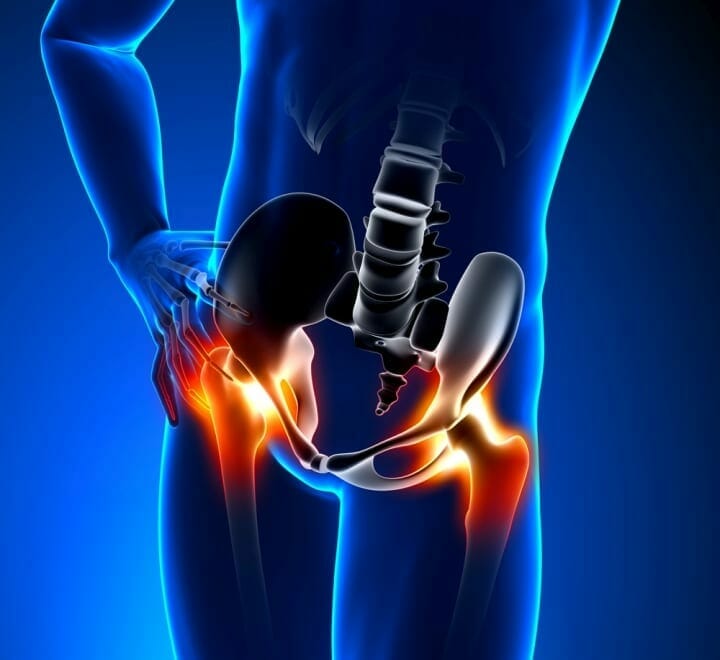Hip pain is a common symptom experienced by people with fibromyalgia. Fibromyalgia is a chronic disorder characterized by widespread musculoskeletal pain, fatigue, and tenderness in localized areas. The pain associated with fibromyalgia can be debilitating and can affect a person’s quality of life.

The hips are a common area of fibromyalgia pain. The pain can be felt in the joints, muscles, or both. The pain may be constant or intermittent and can be severe. People with fibromyalgia may also experience stiffness in the hips, making it difficult to move around comfortably. Hip pain in fibromyalgia can be caused by a variety of factors, including inflammation, muscle tension, and joint dysfunction.
It is important for people with fibromyalgia to seek medical attention for hip pain. A healthcare provider can help diagnose the underlying cause of the pain and recommend appropriate treatment options. Sometimes there may be an alternate diagnosis like rheumatoid arthritis or lupus contributing to the pain. Treatment may include medication, physical therapy, and lifestyle changes. With proper management, people with fibromyalgia can reduce the severity of their hip pain and improve their overall quality of life.
Understanding Hip Pain and Fibromyalgia
Hip pain is a common symptom of fibromyalgia, a chronic condition that causes widespread pain, fatigue, and other symptoms. Fibromyalgia pain can affect different parts of the body, including the hips, lower back, neck, shoulders, and other areas.
Hip pain in fibromyalgia can be caused by tender points around the lower back, hip flexors, and other trigger point areas. The hip flexor muscles allow the hips to move with flexibility, and when these muscles are affected by fibromyalgia, it can cause pain and discomfort.
Fibromyalgia pain is often described as a dull ache or burning sensation that can be felt in different parts of the body. The pain can be mild or severe and can be accompanied by other symptoms such as fatigue, sleep disturbances, and mood changes.
Hip pain in fibromyalgia can be managed with a combination of medication, physical therapy, and lifestyle changes. Medications such as pain relievers, antidepressants, and anticonvulsants can help reduce pain and improve sleep quality. Physical therapy can help improve muscle strength and flexibility, which can reduce pain and improve mobility.
Lifestyle changes such as regular exercise, stress reduction techniques, and a healthy diet can also help manage fibromyalgia pain and improve overall health. It’s important to work with a healthcare provider to develop an individualized treatment plan that addresses your specific symptoms and needs.
In summary, hip pain is a common symptom of fibromyalgia, a chronic condition that causes widespread pain and other symptoms. Fibromyalgia pain can be managed with medication, physical therapy, and lifestyle changes, and it’s important to work with a healthcare provider to develop an individualized treatment plan.

Causes and Risk Factors
The exact cause of hip pain in fibromyalgia patients is not yet clear. However, researchers believe that it may be due to a combination of factors, including physical and emotional trauma, environmental factors, and the underlying condition of fibromyalgia.
Physical trauma, such as a fall or car accident, can cause damage to the hip joint and lead to chronic pain. Additionally, repetitive stress injuries or overuse can also cause hip pain. People with rheumatoid arthritis, an autoimmune disease that causes joint inflammation, are also at an increased risk of developing hip pain.
Emotional trauma, such as stress or anxiety, can also contribute to hip pain in fibromyalgia patients. Stress can cause muscle tension and increase pain sensitivity, which can lead to hip pain.
Environmental factors, such as cold weather or changes in barometric pressure, can also trigger hip pain in some people with fibromyalgia. Exposure to chemicals or toxins may also play a role in the development of hip pain.
Several risk factors have been identified for the development of fibromyalgia, including being female, having a family history of fibromyalgia, and experiencing physical or emotional trauma. Additionally, people with autoimmune diseases, such as rheumatoid arthritis, are also at an increased risk of developing fibromyalgia.
In conclusion, several factors may contribute to hip pain in fibromyalgia patients, including physical and emotional trauma, environmental factors, and the underlying condition of fibromyalgia. Understanding the potential causes and risk factors can help individuals manage and prevent hip pain associated with fibromyalgia.
Diagnosis of Fibromyalgia and Hip Pain
Diagnosis of fibromyalgia can be challenging as there is no definitive test to diagnose this condition. Healthcare providers typically diagnose fibromyalgia based on a combination of a patient’s symptoms and a physical examination. They may also perform blood tests to rule out other conditions that may have similar symptoms.
Blood tests may include a complete blood count, erythrocyte sedimentation rate, cyclic citrullinated peptide test, rheumatoid factor, thyroid function tests, anti-nuclear antibody, celiac serology, and vitamin D. If there is a chance that the patient may be suffering from sleep apnea, the doctor may recommend an overnight sleep study.
In addition to blood tests, healthcare providers may also perform a physical examination to check for fibromyalgia tender points. These tender points are specific areas of the body that are painful when pressure is applied. There are 18 tender points in total, and a patient must have pain in at least 11 of them to be diagnosed with fibromyalgia.
Symptoms of fibromyalgia can vary from person to person, but common symptoms include widespread pain, fatigue, sleep disturbances, and cognitive difficulties. Patients with fibromyalgia may also experience other symptoms, such as headaches, irritable bowel syndrome, restless legs, painful menstrual periods, and trouble thinking clearly (also known as “fibro fog”).
When it comes to hip pain with fibromyalgia, patients may experience pain in the hips, hip flexors, and lower back due to tender areas around the lower back and many more trigger point areas that affect the surrounding areas. The hip flexor muscles allow the hips to move with flexibility. Healthcare providers may also perform a physical examination to check for pain and tenderness in these areas, as well as other symptoms that may be related to fibromyalgia.
Symptoms and Effects
Fibromyalgia is a chronic condition that causes widespread musculoskeletal pain, fatigue, and tenderness in localized areas. One of the hallmark symptoms of fibromyalgia is severe pain that affects the entire body, including the hips and lower back. The pain levels can vary from person to person, but it is typically a constant pain that can be described as a dull ache.
In addition to the pain, many people with fibromyalgia experience leg pain and stiffness, which can make it difficult to walk or move around. The hip joint is also commonly affected, causing pain and discomfort when walking, standing, or sitting for long periods of time.
The effects of fibromyalgia on a person’s quality of life can be significant. The constant pain and fatigue can make it difficult to perform daily activities, such as household chores or work tasks. Many people with fibromyalgia also experience sleep disturbances, which can further exacerbate their symptoms.
In addition to physical symptoms, fibromyalgia can also have psychological effects. Many people with fibromyalgia experience anxiety and depression, which can be caused by the chronic pain and the impact it has on their daily life.
Overall, fibromyalgia is a complex condition that can have a significant impact on a person’s physical and emotional well-being. It is important for individuals with fibromyalgia to work with their healthcare provider to develop a comprehensive treatment plan that addresses their symptoms and improves their overall quality of life.

Impact on Daily Activities and Lifestyle
Hip pain can have a significant impact on daily activities and lifestyle for those with fibromyalgia. The pain can make it difficult to perform simple tasks such as walking, standing, and sitting for extended periods of time. This can lead to a decrease in physical activity, which can further exacerbate symptoms.
In addition to physical limitations, fibromyalgia can also cause sleep problems and cognitive issues such as “fibro fog.” Sleep disturbances are common in fibromyalgia and can lead to poor sleep quality, severe tiredness, and difficulty concentrating during the day. This can make it challenging to complete daily tasks and maintain a regular schedule.
Fibromyalgia can also cause anxiety, depression, and other mood disorders, which can further impact daily activities and lifestyle. These conditions can make it difficult to engage in social activities, work, and other responsibilities.
To manage hip pain and other symptoms of fibromyalgia, it is important to adopt a comprehensive treatment plan that includes medication, physical therapy, and lifestyle modifications. This can help improve mobility, reduce pain, and enhance overall quality of life.
Some lifestyle modifications that may be helpful for managing hip pain in fibromyalgia include:
- Gentle exercise: Low-impact activities such as swimming, yoga, and walking can help improve flexibility and strength without exacerbating pain.
- Heat therapy: Applying heat to the affected area can help reduce pain and stiffness.
- Rest: Taking breaks throughout the day and getting adequate rest at night can help reduce fatigue and improve overall well-being.
- Stress management: Engaging in relaxation techniques such as meditation, deep breathing, or massage therapy can help reduce stress and improve mood.
By incorporating these strategies into their daily routine, individuals with fibromyalgia can help manage hip pain and other symptoms, and improve their overall quality of life.
Management and Treatment Options
There are several management and treatment options available for hip pain associated with fibromyalgia. Treatment plans are often tailored to the individual patient and may involve a combination of therapies to provide optimal pain relief and management.
Pain Relief
The primary goal of treatment for hip pain with fibromyalgia is to relieve pain. Over-the-counter pain medications such as acetaminophen and nonsteroidal anti-inflammatory drugs (NSAIDs) may be helpful for mild to moderate pain. However, for more severe pain, prescription medications may be necessary.
Pain Management
In addition to pain relief, pain management strategies may be employed to help patients better cope with their pain. Physical therapy and occupational therapy can be helpful in managing pain, improving mobility, and increasing strength and flexibility.
Physical Therapy
Physical therapy can involve a variety of exercises and techniques to help reduce pain and improve function. A physical therapist may recommend exercises to help improve range of motion, strength, and flexibility. They may also use modalities such as heat or ice therapy, electrical stimulation, or ultrasound to help reduce pain and inflammation.
Prescription Medications
For more severe pain, prescription medications may be necessary. Medications such as duloxetine, milnacipran, pregabalin, and amitriptyline have been shown to be effective in treating fibromyalgia. Each of these drugs is prescribed for other conditions, such as depression or nerve pain, but they may also be effective in relieving pain associated with fibromyalgia.
Treatment of Fibromyalgia
In addition to treating hip pain, it is important to address the underlying fibromyalgia. A combination of treatments may be necessary to manage symptoms effectively. This may include medications, physical therapy, and lifestyle modifications such as stress reduction techniques, exercise, and a healthy diet.
In conclusion, there are several management and treatment options available for hip pain with fibromyalgia. Treatment plans are often tailored to the individual patient and may involve a combination of therapies to provide optimal pain relief and management. It is important to work with a healthcare provider to determine the best course of treatment for each patient.
